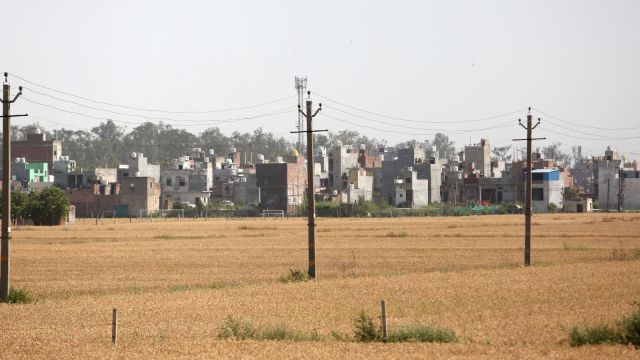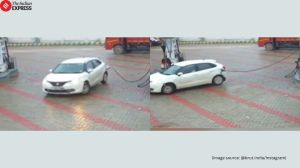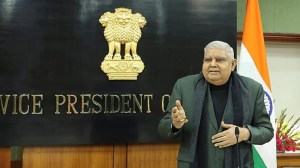Delhi Hardlook | 17 lakh homes in Delhi’s villages: Why DDA’s ambitious land pooling scheme failed to take off for years
For years, the DDA has been building homes across the city, targeting every segment. But with land prices shooting up, it introduced an ambitious land pooling policy in 2007 aimed at developing land in rural areas. However, getting villagers on board has been easier said than done. The Indian Express explores why.
 Ibrahimpur village at Sector 8B in Zone P2, the only sector that has formed a consortium (Express Photo/Gajendra Yadav)
Ibrahimpur village at Sector 8B in Zone P2, the only sector that has formed a consortium (Express Photo/Gajendra Yadav)Virender Mann owns four acres of land, along with his six brothers, on the northeastern edge of Delhi in Hiranki village — among 105 villages eligible for the Delhi Development Authority’s (DDA) land pooling policy.
Last month, a notice from the DDA left the 54-year-old farmer stumped. It asks him to participate voluntarily in the policy — which involves landowners of a particular area coming together and readily pooling their land to build houses and common facilities like roads and sewers — in the next 15 days. If he doesn’t, the agency would either acquire his property or charge him a development fee, much more than what the other landowners are paying.
“We had land in Shahpur Jat, and we lost it in 1965… We haven’t got an alternative plot so far from the DDA,” he says. “… Ab yeh bhi zameen dedi toh hum kisano ka wajood hi kya bachega. Hum kheti bandh karenge, toh phir hume kab tak makaan milega (If we give this piece of land too, then what is the meaning of our existence. If we stop farming now, when will we get our land back)” he asks.
Mann’s concerns, and those of other villagers, are one of several reasons why the policy has hardly seen any progress almost two decades after it was first proposed.
The DDA, meanwhile, has been mulling over making the policy mandatory. “The DDA, after consultation with stakeholders, has submitted a proposal to the Government to amend the Delhi Development Act, 1957, which includes mandatory land pooling to facilitate smooth implementation of land pooling policy in Delhi,” the Housing Ministry said in a reply to a question in the Parliament last August.
Amendments to the DDA Act that would give the policy a push have been pending since 2022.
The DDA did not respond to requests for comment from The Indian Express.
Last month, South Delhi BJP MP Ramvir Singh Bidhuri had said the agency is working on ensuring the smooth implementation of the land pooling policy, citing a communication in this regard from Union Minister for Power, Housing & Urban Affairs Manohar Lal Khattar.
Amid these developments, The Indian Express spoke to farmers, DDA officials and experts about the roadblocks and the possible way forward.
On the ground
Introduced in 2007, in the Master Plan for Delhi 2021, the policy envisages world-class neighbourhoods with high-rise residential housing buildings in the rural belt of Outer Delhi areas such as Narela, Bawana and Najafgarh, where haphazard development is currently underway.
Earlier, the DDA used to acquire land directly, build flats and other public amenities such as parks and community centres, and then sell these flats. However, land acquisition, as per the DDA website, has become increasingly tedious due to high land costs, litigation and procedural delays.
This policy was the agency’s attempt to do away with costly land acquisition and bring in the private sector to build homes. Under it, the DDA will get 40% of the pooled land to build common-use facilities like roads and parks, and landowners can develop the remaining 60% of the land into group housing. Eventually, landowners will get back a combination of flats and shops proportionate to the value of the amount of land they pooled.
An initial version of the policy was notified in 2013, but it was later replaced by the current one notified in 2018. The DDA has delineated 138 sectors in six zones (P 1, P 2, N, K 1, L and J) in northern, western and southern Delhi, which are eligible. (See map)

As per the policy, landowners of 70% of contiguous land in a sector have to give consent for their land to be pooled. After this, the sector is eligible for forming a consortium, a representative body responsible for making decisions regarding developing the sector on behalf of landowners. At this stage, the consortium is expected to apply for land pooling, secure plan approval from the DDA, and sign an agreement with it. After this, infrastructure development under the scheme commences.
It’s been seven years since the scheme was notified, and work has not started in even one sector — only about a third (7,662.5 hectares) of land has been pooled out of a total of 20,600 hectares identified. (See box above)
According to a DDA official, only 21 of the 138 sectors have reached the 70% benchmark.
While the agency has issued a notice to landowners in 15 sectors to go ahead with forming a consortium, only one sector — 8B in Zone P2 — has been able to do so. This sector lies in the Northeast corner of Delhi and comprises areas from Hiranki, Ibrahimpur and Gadi Khasro villages.
Here, owners of 80.06% of the land have agreed. The rest received a notice last month stating that if their land is necessary for providing public infrastructure, it would be acquired.
But others whose land is not required for public infrastructure were informed in the same DDA notice that if they don’t agree to the policy, they will get back less developed plot area than those who pooled earlier and will have to pay more Extra Development Charge (EDC). These charges are collected by the DDA to cover expenses related to roads, sewage systems and other civic amenities.
The challenges
According to Ajay Chauhan, a land pooling consultant based in Bakhtwarpur village, there is a lack of trust among villagers. He says the sectors are so big “that around three villages come under a single sector, which leads to many claimants for positions of authority in the consortium”.
“For instance, Sector 3 has Tigipur, Fatehpur and Ramzanpur (villages). But if the sectors had one village each, consortiums would have formed easily… and all the major families can get representation.” His firm offers end-to-end consultancy services, assisting landowners from consortium formation to planning and developing the land.

Anil Thakur, a landowner and builder in Tigipur, says, “Log keh rahe hai ki DDA zameen zapt kar lega, consortium kuchh nuksaan kar dega, isliye nahi ban pa rahe consortium (People are saying the DDA will forcefully keep the land, or the consortium will put us into losses. That’s why consortiums haven’t been formed).”
The lack of work on the ground hasn’t helped matters. “The DDA should at least start showing people that work is starting. That motivates them. How will people be convinced if there is no construction work starting on roads or the Metro in this area?” Chauhan adds.
The DDA, too, has identified these as among the challenges it is facing in implementing the policy.
A presentation accessed by The Indian Express states: ‘Sector size is larger i.e. average size of sector in the range of 200-500 acres’ and ‘difficulty in formation of consortium due to diverse social and economic backgrounds of land owners’.
The DDA then started subdividing its sectors — from 129 sectors initially, there are now 138. There are plans to further subdivide 138 sectors into 177, according to a DDA official.
Jagan Shah, CEO of Infravision Foundation and ex-Director of National Institute of Urban Affairs, who was involved in formulating the Draft Master Plan for Delhi 2041, says sectors were designed keeping in mind economies of scale. “They would be zero-discharge sectors that would be self-sufficient in terms of processing its own garbage and sewage. If this can happen in smaller sub-divided sectors, I have no problem.”
While the policy envisages rural landowners to give up their land in exchange for an expected rise in the value of the property they get in return, there is no fixed timeline for when developmental work is going to start.
The DDA, in its presentation, also flagged this lack of a fixed timeline while pointing out that there is ‘uncertainty about access roads either at Sector or Zonal level’. “We will have to invest some amount of seed money to create roads and other public infrastructure to show people,” a DDA official says.
Another major challenge is joint ownership of land. In most cases, ancestral land is fragmented into very small land parcels.
Devender Chauhan, a landowner of Sector 8B, says, “We have one acre of land, which is owned by 30 people. Half of them are not here, and the other half don’t know about it. Hum logon ko knowledge hi nahi hai zyada in cheezon ke baare mein (We don’t know a lot about these things).” He has not submitted his land for the policy.
Bhupender Bazad, president of the Delhi Master Plan Committee, Delhi Dehat Vikas Manch (Delhi Villages Development Front), says, “Right now, there are no provisions for joint owners to separate their part of the land and give consent for it to be pooled. The DDA Act, 1957, will have to be amended for this.”
Yet another roadblock, as per DDA, is “little incentive for developers and corporate entities due to low FAR”.
FAR, or Floor Area Ratio, is used in urban planning to regulate density and control development in a city. A higher FAR means more floors or larger buildings can be constructed and is more attractive for builders; inversely, a lower FAR restricts construction to maintain open spaces.
According to the current residential FAR, which is 200, a builder can construct up to 25,395 sq ft of residential area in an acre. “There is a proposal to increase purchasable FAR to 400. Increasing the FAR to 400 would mean the number of flats that would be allowed to be built will go up two times,” says Bazad.
Is there a way forward?
A K Jain, former DDA planning commissioner, said there needs to be a mix of compulsory and voluntary land pooling. “The DDA should acquire land for providing common infrastructure, and pay and coordinate with service-providing agencies to develop roads, lay sewage drains and electric lines.”
To help move the process forward, according to a Housing Ministry reply, the DDA organised 22 field camps in land pooling villages and set up help desks at tehsil offices to assist landowners in registering on its website. But this has not proved enough.
In his Carnegie India newsletter, policy researcher Anirudh Burman highlights the lack of state involvement as a key flaw in the policy.
Landowners are expected to assemble land, persuade others, and draft layout plans themselves — tasks often fraught with disputes, he says. While making pooling mandatory may solve the problem in some cases, it would not solve the problem of the lack of state involvement in Delhi, he notes.
Drawing on examples from Ahmedabad and Amaravati — where land pooling is being adopted for largescale development — Burman notes that active state participation helped reduce uncertainty and conflicts among landowners.
In 2016, NITI Aayog had cited the example of Andhra Pradesh’s Amaravati for being able to pool 33,000 acres in three months.
In a letter to Prime Minister Narendra Modi last December, Bazad pointed to the mushrooming of unauthorised colonies on village land.
“Nearly 25% of Delhi’s Dehat has been lost to unauthorised colonies,” he said, “and the same shall continue till it is arrested through favourable action on the land pooling policy front.”
A DDA official also asserts that it is important that the policy comes through. “There is no other space in Delhi for large-scale development. Where will all the people live?”













